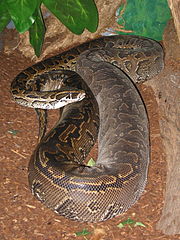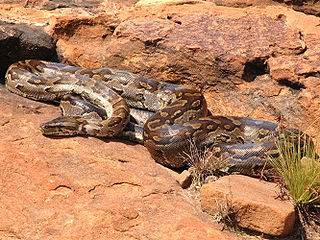At least 45 species of non-native reptiles and amphibians have established breeding populations in Florida. The most notorious of these, the Burmese Python, Python bivittatus, has been much in the news in recent years. Recently, however, another of the state’s introduced giant constrictors grabbed the headlines.
On Sept. 10, 2013, a Northern African Rock Python, P. sebae, killed a 60 pound husky in a suburban yard near the Everglades. While much has been made of the threats posed by large constrictors, what interested me most about this incident was the fact that the snake involved was quite small by Rock Python standards. Despite being only 10 foot long and 38 pounds in weight, the snake was able to overcome and kill a 60 pound dog.
Based on my experiences with large constrictors in the Bronx Zoo and the wild, I would guess that the attack was defensive in nature. The only 60 pound snake meal I’ve witnessed (a White-tailed Deer) involved a 17 foot long, 215 pound Green Anaconda…and its huge body appeared stretched to its limit.
Rock Pythons in Africa and Florida
The husky incident occurred in an area of Miami-Dade County known to harbor a population of African Rock Pythons (please see this article for further information). First observed there in 2002, 25-40 individuals, including juveniles, have been captured since. The dog that was killed weighed 60 pounds – well within the weight range that could be handled by a large African Rock Python. While working at the Bronx Zoo, I often perused back issues of Herpetologica, Copeia and Herpetological Review. Published accounts of African Rock Pythons taking Impala, Baboons and other large animals were common, and I recall several instances of predation upon humans. Tragically, an African Rock Python that escaped its cage killed 2 boys in Canada last month.
The python involved in the instant case was wrapped around the dog’s neck, head and body. It is very likely that the neck hold was critical in allowing the snake to overcome such a large, formidable animal. Pressure in this area can render a person or animal unconscious in seconds. A 5 foot-long Black Ratsnake nearly did so to a co-worker of mine, and healthy young men have been killed by relatively small Burmese Pythons that were allowed to coil about their necks.
Florida’s Other Large, Exotic Constrictors
In addition to Burmese and African Rock Pythons, the Boa Constrictor has established breeding populations in Florida. Green Anacondas, Yellow Anacondas and White-Lipped Pythons have also been reported, but breeding has not been documented. A reliable source informed me that a litter of Green Anacondas escaped into the swamps around Florida City in the early 1970’s, but I have not followed up on the story.
The Florida ranges of African Rock and Burmese Pythons overlap, and it is likely that feral individuals will encounter one another. In captivity, the two species have hybridized. I’m not aware of any studies on the progeny, but would be interested to learn if they differ in habits or size from their parents.
Observations of exotic snakes should be reported to the Florida Fish and Wildlife Commission at www.IVEGOT1.com.
Giant and Odd Snake Meals
From Caiman, Siamese Cats and African Hunting Dogs to centipedes and frog eggs, snakes have been observed feeding on many “unexpected” food items. In Venezuela, a Green Anaconda grabbed my co-worker, in what appeared to be a feeding attempt, while a recent study documented 150 Reticulated Python attacks (6 of which were fatal) in the Philippines. Please see the articles linked below for further details, and be sure to post your thoughts as well.
Further Reading
Reticulated Python Attacks on People (Philippines)
Tagging Anacondas in Venezuela
Feral African Rock Pythons in Florida
 That Reptile Blog – Reptile, Amphibian and Exotic Pet Care and Information
That Reptile Blog – Reptile, Amphibian and Exotic Pet Care and Information





